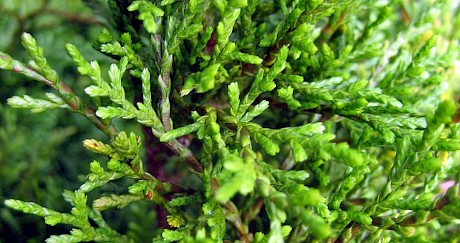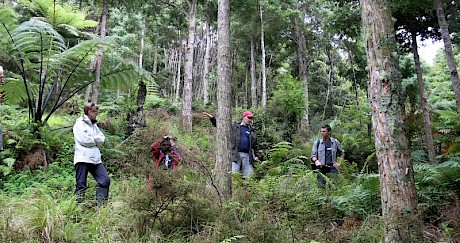Manoao (Manoao colensoi)
Silver Pine
History
Manoao has had a varied history as far as its name is concerned. Originally called Dacrydium westlandicum its name later became Dacrydium colensoi, then Lagarostrobus colensoi. A taxonomy revision in 1995 resulted in its present name.
As far as can be ascertained it was little used by the Maori, despite the high durability of its heartwood. This attribute was highly prized by Europeans who used the timber for posts, poles and sleepers during the early days. Latter-day uses are also in this area although it is now being appreciated as a high quality furniture timber.
Distribution
The species ranges over most of the country from just south of Kaitaia to as far south as the Arawhata River in south Westland. But it is only common in Westland between latitudes 41° 50’ and 44° South, up to an altitude of 500 metres. It is normally found in areas of high rainfall and on poor, poorly drained soils where it has little competition from other species. However it grows best on deep, fertile, well drained soils. It is one of the few native timber species able to propagate itself by root suckers.
Tree size and growth
It grows up to 15 metres tall and one metre diameter but is usually somewhat smaller. Growth rate is normally very slow – in the region of 0.6 to 1.7 mm of diameter annually. However, although no trial data is available, there are indications that it will grow much faster on sites which are drier than the boggy areas where it is normally found.
Timber
Manoao timber is classed as very durable. It is yellowish/white in colour and sometimes mottled. It is straight and even in the grain, dense, firm and compact. Abundant white crystals on the surface of the seasoned wood are the origin of the name “silver pine”. However this makes the wood difficult to paint and varnish. Timber characteristics, with P radiata figures shown in brackets for comparison, are as follows: -
Density @ 12% m.c 610 kg/ m³ (500 kg/m³)
Moisture content: green 65% (130%)
Tangential shrinkage -green to 12% m.c 3.3% (4.7%)
Radial shrinkage 2.0% (2.2%)
Modulus of rupture 61 Mpa (90 Mpa)
Modulus of elasticity 6.4 Gpa (9 Gpa)
Damaging agencies
Manoao is a hardy species with no known fungal or insect diseases. It is very prone to fire damage.
Potential
The species is worthy of study because of its durable attributes. It is also, along with pink pine (Halocarpus biformis), the main source of the chemicals manool and manoyl oxide which are used as substitutes for ambergris in the perfume industry. As far as is known there have been no attempts to grow manoao commercially for this purpose.
Research requirements
Trials with manoao are urgently needed to determine whether it can be grown at rates which are faster than it attains in its natural habitat. Its potential as a producer of valuable chemicals and a very durable timber makes it an ideal candidate for consideration by those interested in growing native species commercially.
References
- Allan H H 1961. Flora of New Zealand Vol. 1 Government Printer Wellington
- Brooker S G, Cambie R C & Cooper R C 1988. Economic Native Plants of New Zealand. Botany Division, D.S.I.R
- Clifton N C 1990. New Zealand timbers
- Farjon A 2001. World Checklist and bibliography of Conifers (2nd ed) Royal Botanical Gardens, Kew
- Hinds H V & Reid J S 1957. Forest Trees and Timbers of New Zealand. Govt Printer Wellington
- Howard A L 1948. A manual of the timbers of the world. MacMillan & Co, London
Species profile by Ian Barton


